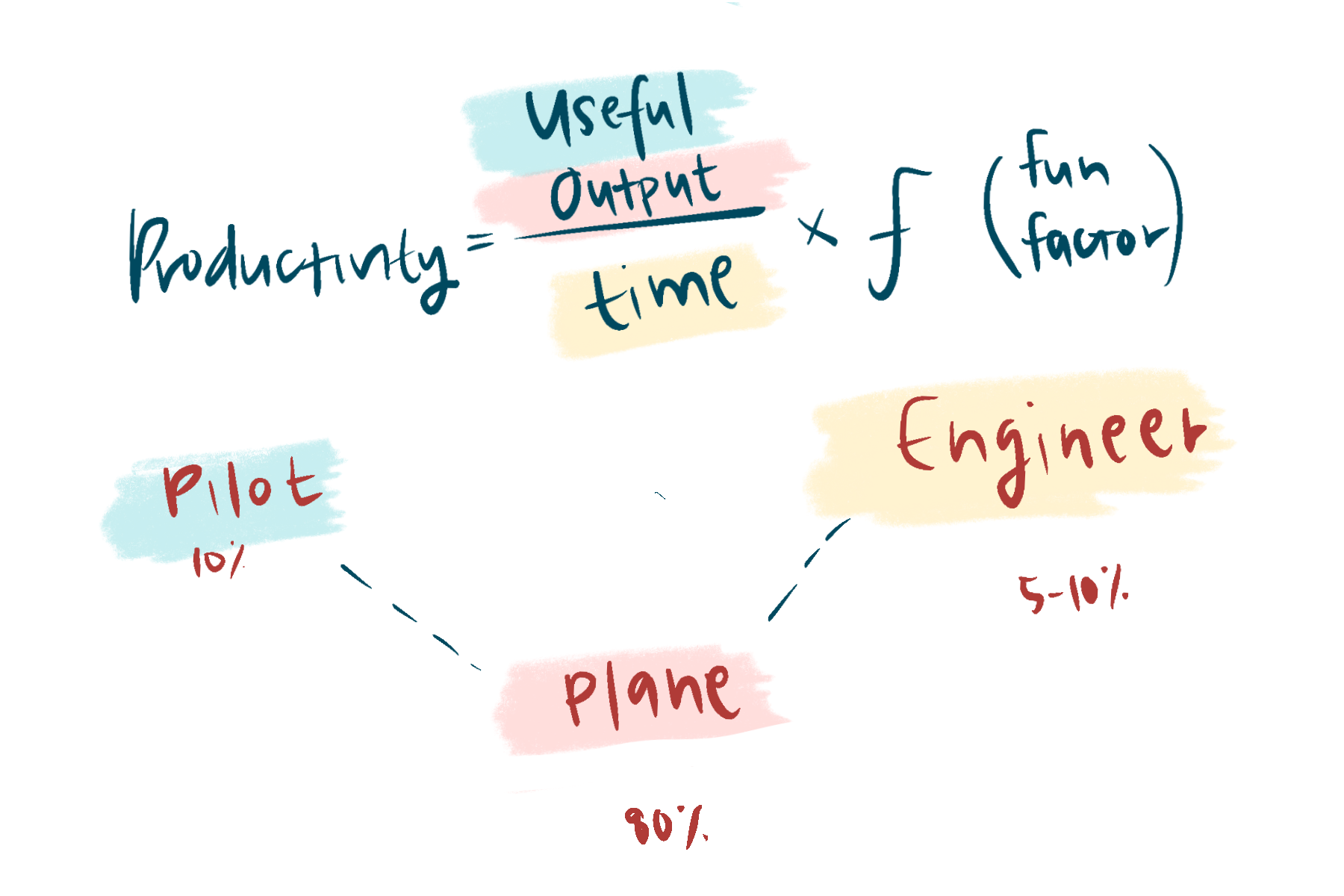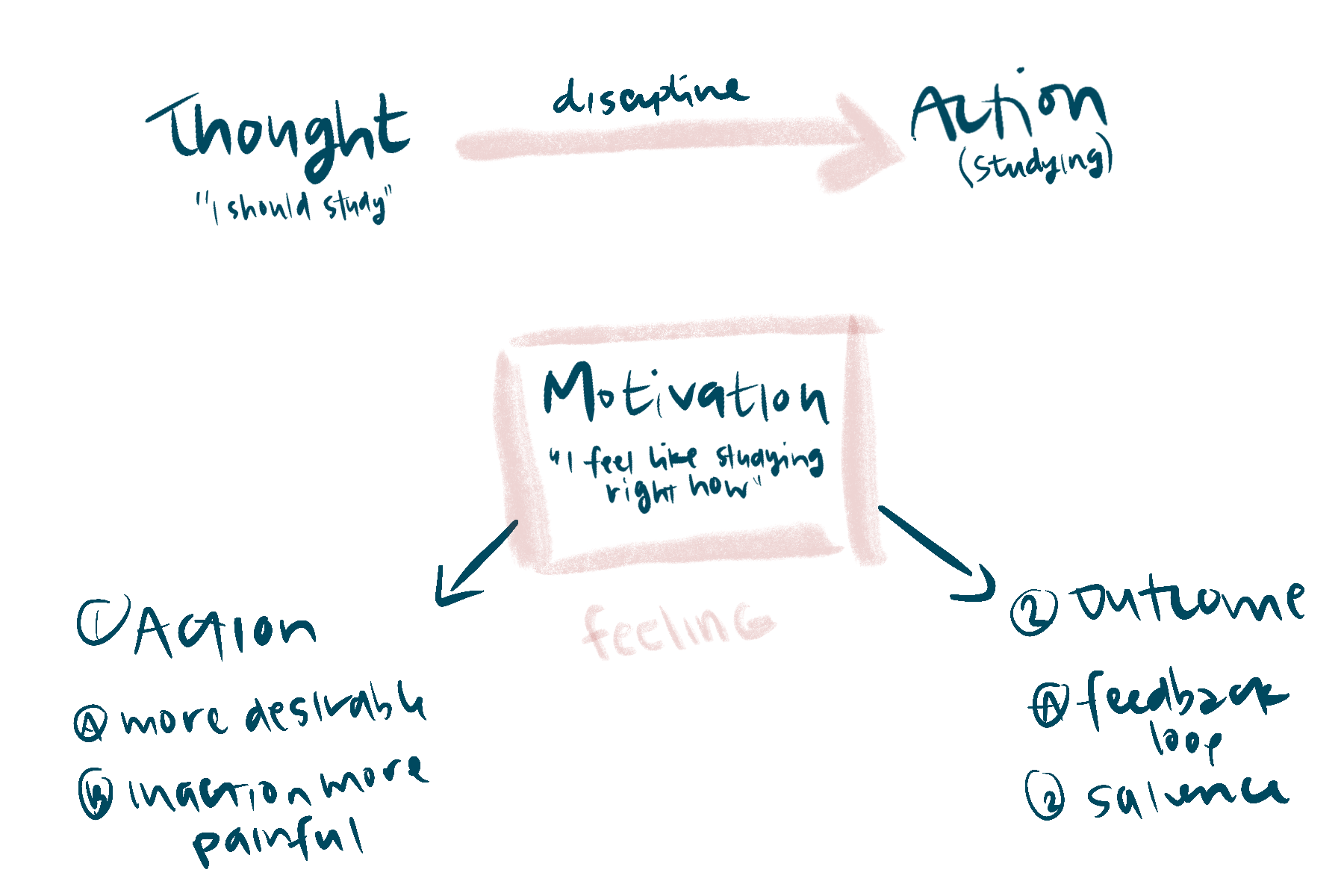Adventure Garden
Powered by 🌱Roam Garden👩🏫 Productivity Masterclass - Principles and Tools to Boost Your Productivity
Metadata
Course Description
"Being productive is really just about understanding the productivity equation and then figuring out which bits we need to optimise to apply to our own lives".
In this first of a series of classes, I want to explore the idea of productivity in more depth - break down the concept into principles and theories as well as laws and powers to provide the foundation to enable us all to understand productivity on a more fundamental level so that we can all work towards living happier, more productive lives.
Key Ideas and Takeaways
Increasing productivity is about figuring out which area we need to focus our time on improving: the pilot, the plane, or the engineer.
The idea of motivation rests on the assumption that we need to want to do a task before we can do it. Fundamentally, motivation is just a feeling, and relying on feelings to determine our productivity and the course of our life is a recipe for disaster.
Try your best to enjoy the things you are doing and if you don't enjoy it, recognize that you have the power within yourself to change that. You can make small changes and ultimately decide to find enjoyment in what you're doing.
Inter-Disciplinary Connections
This course takes ideas and concepts from many productivity books and condenses it into an easily and quickly digestible format so that we can get started right now rather than needing to read ten books first.
Notes
The Productivity Equation
Productivity used to mean the amount of product produced per worker or per working day. These days we don't think of productivity this way. We think of how much work we can get done in the smallest amount of time possible.
productivity = useful output / time *F (fun factor)
It doesn't matter how productive you're being if what you're doing isn't useful.
Additionally, when stuff is fun, it doesn't feel like work. We don't have to worry about motivation or willpower because we like to do it. If we can make our productivity tasks enjoyable, it supercharges everything.
Productivity is more about how we are being productive and not about what we are using to be productive.
Pilot and Plane Analogy

Pilot - set the course of the plane, figure out what direction the plane is heading in.
Plane - follow the course, not deviate, take off efficiently, land safely.
Engineer - make sure the plane is efficient, fuel efficiency (not using too much energy,) keep the system organized.
80% of our time should be in Plane mode, 10-15% in Pilot mode.
The other 5-10% of the time we are the Engineer.
Increasing productivity is not about increasing everything in the equation. Focusing on everything can be a time suck and you may not achieve much. Increasing productivity is about figuring out which area we need to focus our time on improving: the pilot, the plane, or the engineer.
Journaling Prompt 1
The Myth of "I Don't Have Time"
Time is what we want most but what we use worst. William Penn
Our time is entirely within our control - we all have the same amount of time and we all decide how to actively spend our time.
It isn't that we don't have the time, it's that this task isn't high enough on your priority list and you're actively choosing not to make the time.
Eliminate the phrase "I Don't Have Time" from your vocabulary.
The Myth of Motivation
What is motivation?
The whole idea of motivation is getting from the thought to the action without much struggle in-between.
Motivation is the feeling of wanting to do the task.
The trouble here is that we think we have to feel like wanting to do the thing before we do the thing - but we really don't.
It's easy to set the course as the pilot, but taking off as the plane is where a lot of us struggle because we think we need motivation to take off.
Motivation is fundamentally a feeling, and relying on feelings to determine our productivity and the course of our life is a recipe for disaster.
Practical Tips

There are two parts of the equation we can target: the action or the outcome.
If we can make the action more fun or pleasurable, we are more likely to do the thing.
If you're struggling with motivation, look for ways you can make things fun for yourself.
The other thing we can do is make the consequences of inaction more painful.
With the outcome, we can shorten the feedback loop so that we see progress sooner.
Everything you need to do that you don't want to do - turn it into a game with a short feedback loop.
You can also make the outcome more salient, or making the outcome more clear in our minds - this might be why students like to watch 'study with me' videos.
The Myth of Multitasking
Focusing on one thing at a time is infinitely more productive than continually task switching.
'Multitasking' is really just switching tasks quickly.
The flow state is a phrase used by Mihaly Csikszentmihalyi to describe when you're in your optimal state and working and time is just flying by.
Productivity, without enjoyment, is not as productive because you cannot get into the flow state.
Comfort Zone, Stretch Zone, Panic Zone > we want to be in the stretch zone, where things are difficult enough to keep you interested, but not so difficult that it becomes frustrating.
We should think about, whatever we're doing, how to get into that stretch zone so we can get to our flow state.
Once we get into the flow state, we want to avoid distractions. Any kind of distraction will take us out of the flow state, and it may be difficult to get back.
If we are getting distracted by things like our phone, we are allowing ourselves to get distracted. You choose to be distracted.
Parkinson's Law
Work expands to fill the time that we allocate to it. Cyril Parkinson
Having too much time to do something is a recipe for procrastination.
In the book 📖 Zero to One by Peter Thiel, he urges his readers to think about their ten year plan and then think about how they're going to achieve it within the next six months. How can we make this possible?
Pareto Principle
80% of the results will come from 20% of the effort. We can hack our pilot to focus on the 20% of things that will result in 80% of the output.
Newton's First Law of Motion
This is actually a law of physics, but it applies to productivity as well.
Newton's First Law of Motion states that an object is at rest or traveling at a constant velocity unless it's acted on by an external imbalanced force. What does that mean? That means if something is still, it will stay still by default, and if something is moving, it will continue to move at a constant speed, a constant velocity by default, unless an external force acts on it.
If we are not doing anything, it requires an external force to make us do something. If we are already moving or doing something, it is much easier to keep going.
Sometimes all it takes is that one little push to get going and then it's easier to keep going. We can hack our brains into getting started.
2 minute rule from David Allen's Getting Things Done states that if something takes less than two minutes, you should just do it now rather than putting it on your to-do list. Putting it off means we might not do it, and it might make the thing feel bigger than it is because we've made it a project and put it on our to-do list.
5 minute rule says that if we are struggling to get started with any task, all we have to do is just do five minutes of it. If we can convince our brains that we only have to do five minutes of it, it's easier to get started and then all we have to do is just keep going.
The Power of Habits
In 📖 Atomic Habits by James Clear, the author states that habits themselves should be atomic. They're small fundamental units of self-development of being productive and there's no point in having fancy productivity apps if we don't have the corresponding habits to use the app appropriately. Habits are essential.
Small habits can make large behavioral changes over time. Many small habits build on top of each other over time and the resulting change can be quite drastic.
The Power of Productive Downtime
Every day we have tons of downtime that we don't do anything with. If we take this downtime and do something useful with it, we can accomplish loads more than if we just sat on our phones scrolling through social media.
The Daily Highlight - ask yourself every morning what you want the highlight to be? What do you want to focus on? What is the one thing you want to get done today?
Sometimes adding massively small items to your to-do list just to tick them off can give you that boost of 'oh! I'm being productive!' and it's easier to get started on the other tasks on your list then, because you don't want to leave the list half-ticked off.
This helps increase useful output!
Some of us convince ourselves we need more downtime than we actually do. This is something to think about!
The Power of Productive Procrastination
If you're going to procrastinate, procrastinate doing something productive. For example, if procrastinating from doing something you're supposed to be doing, at least use that time doing something else that is productive.
I have the tendency to procrastinate by learning new things.
The Fun Factor
What is the point of being productive if we're not enjoying it?
Who cares how well or how bad you're doing if you're not enjoying what you're doing? Why devote x amount of days or hours or years of your life to something that isn't fun?
Always try to do things to make what you're doing more fun.
Seth Godin wrote a blog post titled 'The gap between 'have to' and 'get to'' and said that any time we're struggling with something we have to do, we should reframe it in our minds from 'I have to do this' to 'I get to do this.' This reminds us about the gratitude we feel for what we have in our lives.
Additional Resources
Books
Inside the Mind of a Master Procrastinator
The Motivation Myth